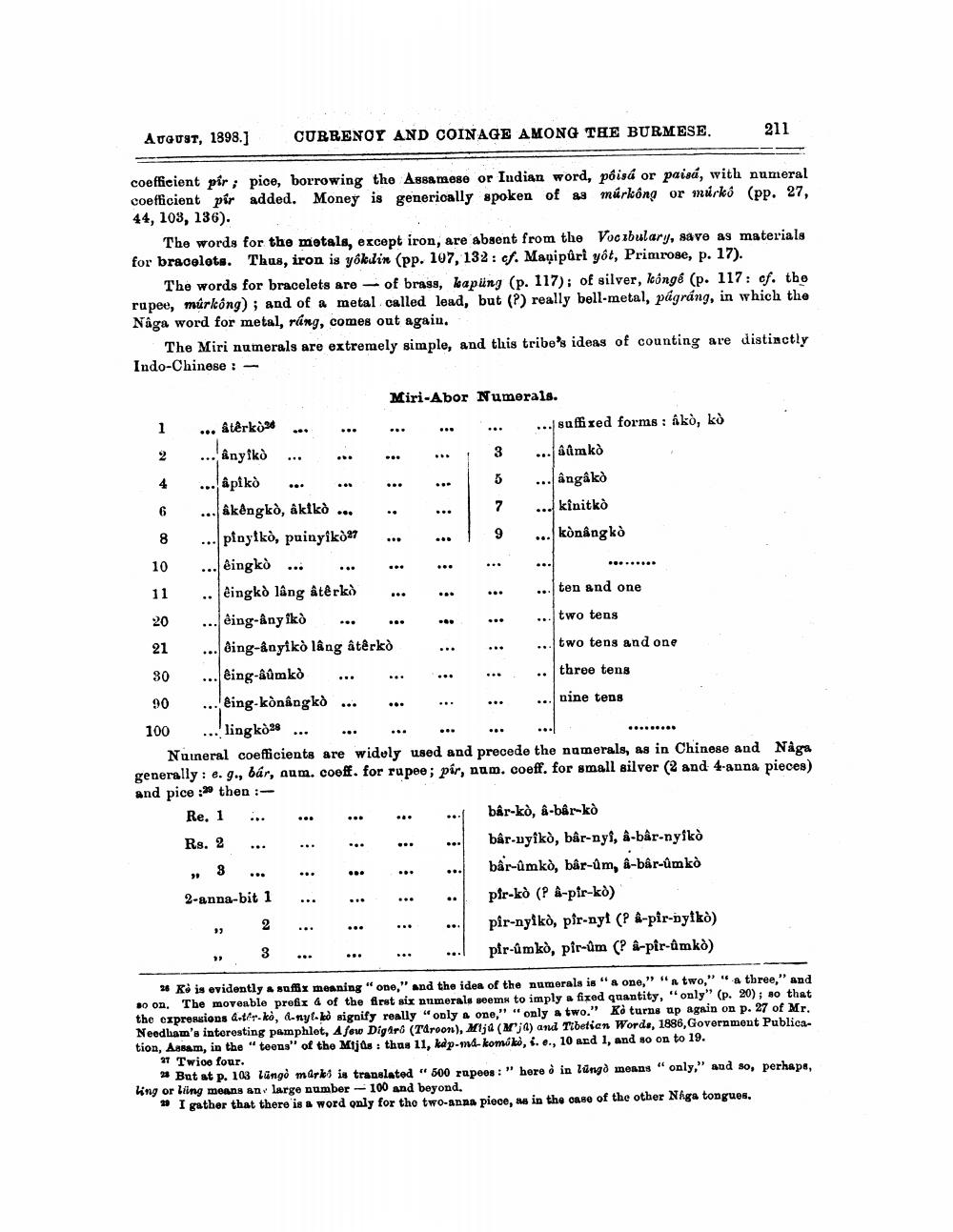________________
AUGUST, 1898.]
CUBRENOY AND COINAGE AMONG THE BURMESE.
211
coefficient per ; pioe, borrowing the Assamese or Indian word, põisa or paisa, with numeral coefficient per added. Money is generically spoken of a múrkông or márki (pp. 27, 44, 103, 136).
The words for the metals, except iron, are absent from the Vocabulary, save as materials for bracelots. Thus, iron is yokdin (pp. 107, 132: ef. Manipuri yôt, Primrose, p. 17).
The words for bracelets are of brass, kapüng (p. 117); of silver, kóngé (p. 117: of. the rupee, múricông); and of a metal called lead, but (?) really bell-metal, págráng, in which the Någa word for metal, ráng, comes out again.
The Miri numerals are extremely simple, and this tribe's ideas of counting are distinctly Indo-Chinese : -
Miri-Abor Numerals. ... atêrkom
... ...suffired forms: Ako, ko ... anyiko
... aumkò ... apik) ...
... Ôngako ... akêngkò, akikò ...
...kinitko pinyłkò, puinyiko27
... kònângko ... eingko ... .. êingko lâng stêrk)
... ten and one 20 ... êing-Ânyiko ... ...
two tens 21 ... Ôing-ânyiko lâng ôtêrko
two tens and one 30 ... eing-aumkd ... ... ... ... .. three tens 90 ... eing-kònâng kd ...
nine tens 100 ... lingkò28 ... ...
Naineral coefficients are widely used and precede the namerals, as in Chinese and Naga generally : e. g., bár, aum. coeff. for rupee; pír, num. coeff. for small silver (2 and 4-anna pieces) and pice :3 then :Re, 1 ...
bâr-kò, &-bar-kò Rs. 2 ...
bâr-vyîkò, bâr-nys, a-bâr-nyikò
bâr-ümkò, bâr-ûm, -bar-ům kò 2-anna-bit
pir-kò (? &-pir-kò)
pir-nyikò, pir-nyi (Pd-pir-nyiko) , 3 ...
pfr-îmkò, pîr-üm (? &-pir-âmkd)
26 K) is evidently suffix meaning "one," and the idea of the numerals is" a ono," "a two," "a three," and 20 on. The moveable prefix 4 of the first six aumerals seems to imply a fixed quantity, "only" (p. 20); so that the expressions 4.11. kò, d-nylko signify really "only one," "only a two." Kò turns up again on p. 27 of Mr. Needham's interesting pamphlet, A few Digir (Taroon), Mijd (M'ja) and Tibetien Words, 1886, Government Publication, Assam, in the "teens" of the Mijas: thus 11, kap-md-komók), i. e., 10 and 1, and so on to 19.
37 Twioe four.
» But at p. 103 lungo marks is translated " 500 rupees: " bere è in longd means "only," and so, perhape, king or ling means any large number - 100 and beyond.
# I gather that there is a word only for the two-anaa piece, in the 01s0 of the other Nhga tongues.




